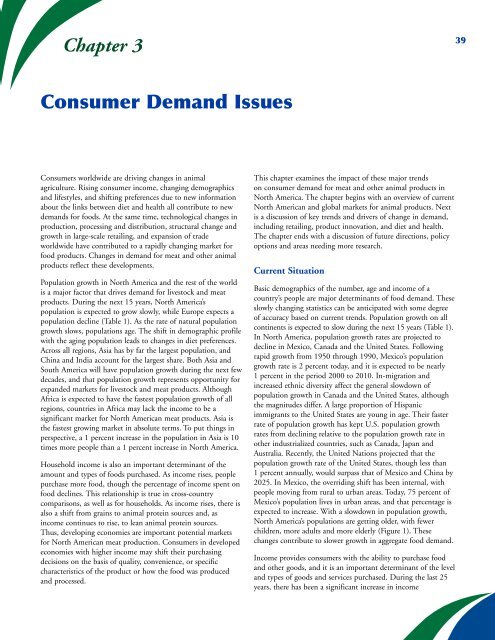The Future of Animal Agriculture in North America - Farm Foundation
The Future of Animal Agriculture in North America - Farm Foundation
The Future of Animal Agriculture in North America - Farm Foundation
Create successful ePaper yourself
Turn your PDF publications into a flip-book with our unique Google optimized e-Paper software.
Chapter 3<br />
Consumer Demand Issues<br />
Consumers worldwide are driv<strong>in</strong>g changes <strong>in</strong> animal<br />
agriculture. Ris<strong>in</strong>g consumer <strong>in</strong>come, chang<strong>in</strong>g demographics<br />
and lifestyles, and shift<strong>in</strong>g preferences due to new <strong>in</strong>formation<br />
about the l<strong>in</strong>ks between diet and health all contribute to new<br />
demands for foods. At the same time, technological changes <strong>in</strong><br />
production, process<strong>in</strong>g and distribution, structural change and<br />
growth <strong>in</strong> large-scale retail<strong>in</strong>g, and expansion <strong>of</strong> trade<br />
worldwide have contributed to a rapidly chang<strong>in</strong>g market for<br />
food products. Changes <strong>in</strong> demand for meat and other animal<br />
products reflect these developments.<br />
Population growth <strong>in</strong> <strong>North</strong> <strong>America</strong> and the rest <strong>of</strong> the world<br />
is a major factor that drives demand for livestock and meat<br />
products. Dur<strong>in</strong>g the next 15 years, <strong>North</strong> <strong>America</strong>’s<br />
population is expected to grow slowly, while Europe expects a<br />
population decl<strong>in</strong>e (Table 1). As the rate <strong>of</strong> natural population<br />
growth slows, populations age. <strong>The</strong> shift <strong>in</strong> demographic pr<strong>of</strong>ile<br />
with the ag<strong>in</strong>g population leads to changes <strong>in</strong> diet preferences.<br />
Across all regions, Asia has by far the largest population, and<br />
Ch<strong>in</strong>a and India account for the largest share. Both Asia and<br />
South <strong>America</strong> will have population growth dur<strong>in</strong>g the next few<br />
decades, and that population growth represents opportunity for<br />
expanded markets for livestock and meat products. Although<br />
Africa is expected to have the fastest population growth <strong>of</strong> all<br />
regions, countries <strong>in</strong> Africa may lack the <strong>in</strong>come to be a<br />
significant market for <strong>North</strong> <strong>America</strong>n meat products. Asia is<br />
the fastest grow<strong>in</strong>g market <strong>in</strong> absolute terms. To put th<strong>in</strong>gs <strong>in</strong><br />
perspective, a 1 percent <strong>in</strong>crease <strong>in</strong> the population <strong>in</strong> Asia is 10<br />
times more people than a 1 percent <strong>in</strong>crease <strong>in</strong> <strong>North</strong> <strong>America</strong>.<br />
Household <strong>in</strong>come is also an important determ<strong>in</strong>ant <strong>of</strong> the<br />
amount and types <strong>of</strong> foods purchased. As <strong>in</strong>come rises, people<br />
purchase more food, though the percentage <strong>of</strong> <strong>in</strong>come spent on<br />
food decl<strong>in</strong>es. This relationship is true <strong>in</strong> cross-country<br />
comparisons, as well as for households. As <strong>in</strong>come rises, there is<br />
also a shift from gra<strong>in</strong>s to animal prote<strong>in</strong> sources and, as<br />
<strong>in</strong>come cont<strong>in</strong>ues to rise, to lean animal prote<strong>in</strong> sources.<br />
Thus, develop<strong>in</strong>g economies are important potential markets<br />
for <strong>North</strong> <strong>America</strong>n meat production. Consumers <strong>in</strong> developed<br />
economies with higher <strong>in</strong>come may shift their purchas<strong>in</strong>g<br />
decisions on the basis <strong>of</strong> quality, convenience, or specific<br />
characteristics <strong>of</strong> the product or how the food was produced<br />
and processed.<br />
This chapter exam<strong>in</strong>es the impact <strong>of</strong> these major trends<br />
on consumer demand for meat and other animal products <strong>in</strong><br />
<strong>North</strong> <strong>America</strong>. <strong>The</strong> chapter beg<strong>in</strong>s with an overview <strong>of</strong> current<br />
<strong>North</strong> <strong>America</strong>n and global markets for animal products. Next<br />
is a discussion <strong>of</strong> key trends and drivers <strong>of</strong> change <strong>in</strong> demand,<br />
<strong>in</strong>clud<strong>in</strong>g retail<strong>in</strong>g, product <strong>in</strong>novation, and diet and health.<br />
<strong>The</strong> chapter ends with a discussion <strong>of</strong> future directions, policy<br />
options and areas need<strong>in</strong>g more research.<br />
Current Situation<br />
Basic demographics <strong>of</strong> the number, age and <strong>in</strong>come <strong>of</strong> a<br />
country’s people are major determ<strong>in</strong>ants <strong>of</strong> food demand. <strong>The</strong>se<br />
slowly chang<strong>in</strong>g statistics can be anticipated with some degree<br />
<strong>of</strong> accuracy based on current trends. Population growth on all<br />
cont<strong>in</strong>ents is expected to slow dur<strong>in</strong>g the next 15 years (Table 1).<br />
In <strong>North</strong> <strong>America</strong>, population growth rates are projected to<br />
decl<strong>in</strong>e <strong>in</strong> Mexico, Canada and the United States. Follow<strong>in</strong>g<br />
rapid growth from 1950 through 1990, Mexico’s population<br />
growth rate is 2 percent today, and it is expected to be nearly<br />
1 percent <strong>in</strong> the period 2000 to 2010. In-migration and<br />
<strong>in</strong>creased ethnic diversity affect the general slowdown <strong>of</strong><br />
population growth <strong>in</strong> Canada and the United States, although<br />
the magnitudes differ. A large proportion <strong>of</strong> Hispanic<br />
immigrants to the United States are young <strong>in</strong> age. <strong>The</strong>ir faster<br />
rate <strong>of</strong> population growth has kept U.S. population growth<br />
rates from decl<strong>in</strong><strong>in</strong>g relative to the population growth rate <strong>in</strong><br />
other <strong>in</strong>dustrialized countries, such as Canada, Japan and<br />
Australia. Recently, the United Nations projected that the<br />
population growth rate <strong>of</strong> the United States, though less than<br />
1 percent annually, would surpass that <strong>of</strong> Mexico and Ch<strong>in</strong>a by<br />
2025. In Mexico, the overrid<strong>in</strong>g shift has been <strong>in</strong>ternal, with<br />
people mov<strong>in</strong>g from rural to urban areas. Today, 75 percent <strong>of</strong><br />
Mexico’s population lives <strong>in</strong> urban areas, and that percentage is<br />
expected to <strong>in</strong>crease. With a slowdown <strong>in</strong> population growth,<br />
<strong>North</strong> <strong>America</strong>’s populations are gett<strong>in</strong>g older, with fewer<br />
children, more adults and more elderly (Figure 1). <strong>The</strong>se<br />
changes contribute to slower growth <strong>in</strong> aggregate food demand.<br />
Income provides consumers with the ability to purchase food<br />
and other goods, and it is an important determ<strong>in</strong>ant <strong>of</strong> the level<br />
and types <strong>of</strong> goods and services purchased. Dur<strong>in</strong>g the last 25<br />
years, there has been a significant <strong>in</strong>crease <strong>in</strong> <strong>in</strong>come<br />
39

















